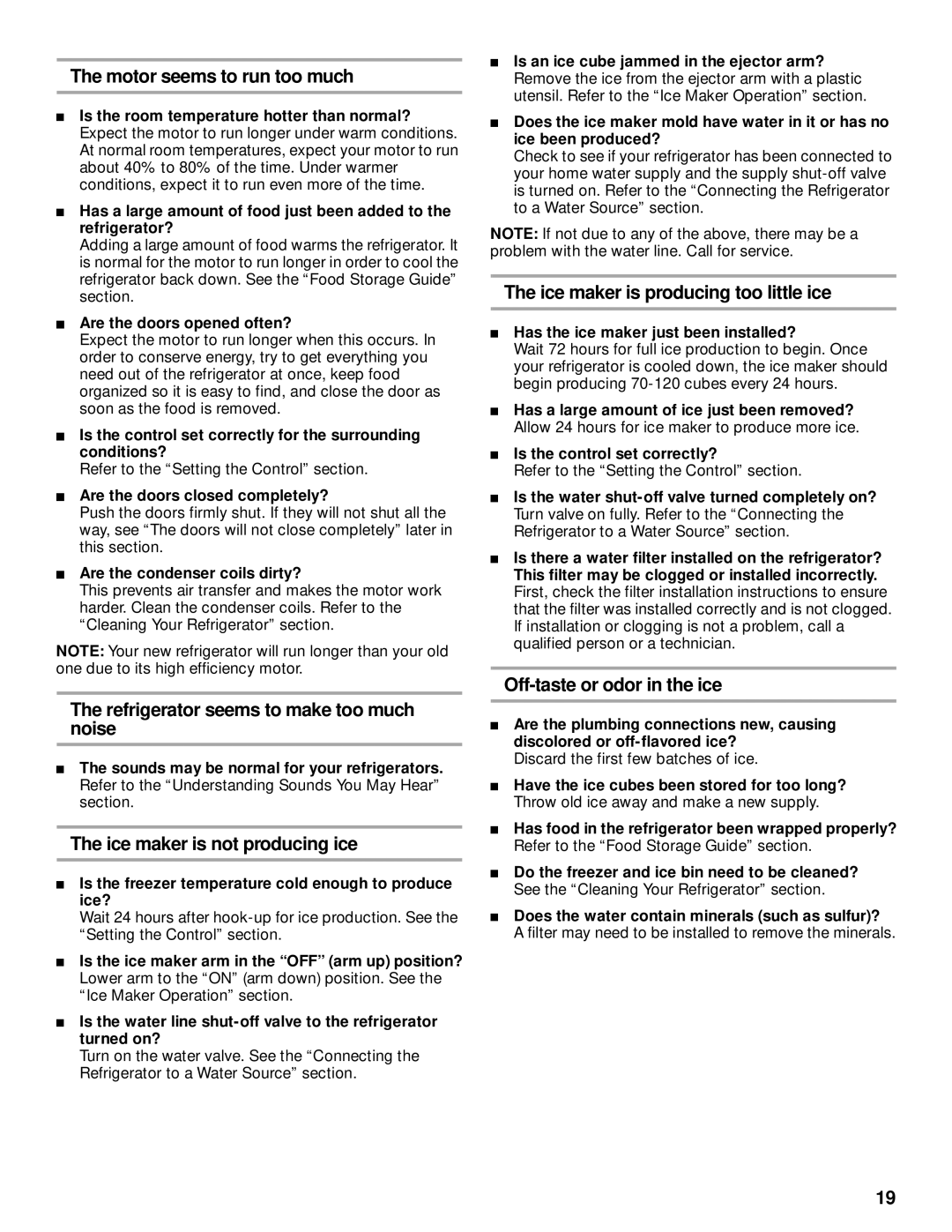
The motor seems to run too much
■Is the room temperature hotter than normal? Expect the motor to run longer under warm conditions. At normal room temperatures, expect your motor to run about 40% to 80% of the time. Under warmer conditions, expect it to run even more of the time.
■Has a large amount of food just been added to the refrigerator?
Adding a large amount of food warms the refrigerator. It is normal for the motor to run longer in order to cool the refrigerator back down. See the “Food Storage Guide” section.
■Are the doors opened often?
Expect the motor to run longer when this occurs. In order to conserve energy, try to get everything you need out of the refrigerator at once, keep food organized so it is easy to find, and close the door as soon as the food is removed.
■Is the control set correctly for the surrounding conditions?
Refer to the “Setting the Control” section.
■Are the doors closed completely?
Push the doors firmly shut. If they will not shut all the way, see “The doors will not close completely” later in this section.
■Are the condenser coils dirty?
This prevents air transfer and makes the motor work harder. Clean the condenser coils. Refer to the “Cleaning Your Refrigerator” section.
NOTE: Your new refrigerator will run longer than your old one due to its high efficiency motor.
The refrigerator seems to make too much noise
■The sounds may be normal for your refrigerators. Refer to the “Understanding Sounds You May Hear” section.
The ice maker is not producing ice
■Is the freezer temperature cold enough to produce ice?
Wait 24 hours after
■Is the ice maker arm in the “OFF” (arm up) position? Lower arm to the “ON” (arm down) position. See the “Ice Maker Operation” section.
■Is the water line
Turn on the water valve. See the “Connecting the Refrigerator to a Water Source” section.
■Is an ice cube jammed in the ejector arm? Remove the ice from the ejector arm with a plastic utensil. Refer to the “Ice Maker Operation” section.
■Does the ice maker mold have water in it or has no ice been produced?
Check to see if your refrigerator has been connected to your home water supply and the supply
NOTE: If not due to any of the above, there may be a problem with the water line. Call for service.
The ice maker is producing too little ice
■Has the ice maker just been installed?
Wait 72 hours for full ice production to begin. Once your refrigerator is cooled down, the ice maker should begin producing
■Has a large amount of ice just been removed? Allow 24 hours for ice maker to produce more ice.
■Is the control set correctly?
Refer to the “Setting the Control” section.
■Is the water
■Is there a water filter installed on the refrigerator? This filter may be clogged or installed incorrectly. First, check the filter installation instructions to ensure that the filter was installed correctly and is not clogged. If installation or clogging is not a problem, call a qualified person or a technician.
Off-taste or odor in the ice
■Are the plumbing connections new, causing discolored or
Discard the first few batches of ice.
■Have the ice cubes been stored for too long? Throw old ice away and make a new supply.
■Has food in the refrigerator been wrapped properly? Refer to the “Food Storage Guide” section.
■Do the freezer and ice bin need to be cleaned? See the “Cleaning Your Refrigerator” section.
■Does the water contain minerals (such as sulfur)? A filter may need to be installed to remove the minerals.
19
